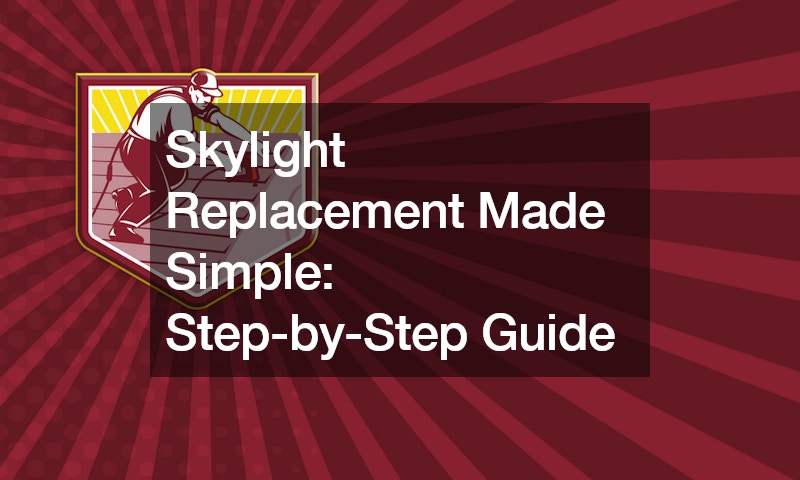Replacing a skylight can be a daunting task for many homeowners, but with the right approach and attention to detail, it can be a manageable project that enhances both the aesthetic and functionality of your home. Whether you’re looking to upgrade an old skylight or need to address leaks and wear, here’s a comprehensive guide to help you through the process.
1. Preparation and Removal
Begin by assessing the condition of the existing skylight and surrounding roof. It’s crucial to ensure that the flashing around the skylight is intact and in good condition, as this prevents water infiltration.
Start by carefully removing the shingles around the skylight using a flat bar and hammer. Take care not to damage the surrounding roof materials during this step.
Once the shingles are removed, focus on the flashing. This thin metal strip is crucial for directing water away from the skylight and preventing leaks. Depending on the type of skylight, you may need to remove additional layers of membrane or sealant to access the fasteners holding the skylight in place. For example, framed flat rooflights often require meticulous disassembly of the frame and careful extraction of any sealant or adhesive securing them to the roof structure. This process ensures that the new skylight fits snugly and securely into the existing opening, maintaining both the structural integrity and aesthetic appeal of your home.
2. Removing the Old Skylight
With the shingles and flashing out of the way, you can now focus on removing the old skylight. Use a utility knife to cut through any remaining sealant or adhesive around the perimeter of the skylight frame. Take your time with this step to avoid damaging the roof decking or surrounding materials.
Once the sealant is cut, carefully lift the old skylight out of its frame. This may require assistance, especially for larger skylights. Be cautious not to drop or damage the skylight as you remove it from the roof opening.
3. Installing the New Skylight
Before installing the new skylight, take the opportunity to make any necessary repairs or adjustments to the roof decking and surrounding structure. Ensure that the opening is clean and free of debris, as this will provide a smooth surface for installing the new skylight.
Position the new skylight in the opening, ensuring that it is centered and level. Use center lines marked on both the skylight and the roof opening to guide the alignment process. Once positioned correctly, secure the skylight in place using appropriate fasteners. Galvanized nails or screws are recommended for their durability and resistance to rust.
4. Flashing and Sealing
Proper flashing is crucial to ensuring a watertight seal around the skylight. Begin by applying a self-sealing membrane along the bottom edge of the skylight. This membrane adheres to both the skylight frame and the roof surface, creating a secure barrier against water penetration.
Next, install metal flashing around the sides and top of the skylight. The flashing should overlap each other in a step-like manner to direct water away from the skylight. Secure the flashing with nails or screws, ensuring that they are driven flush with the surface to prevent any potential leaks.
5. Final Touches
Once the flashing is in place, replace the shingles around the skylight. Start at the bottom and work your way up, ensuring that each shingle overlaps the flashing to maintain a seamless appearance. Use roofing nails to secure the shingles, making sure not to compromise the integrity of the flashing.
After the shingles are installed, apply additional layers of sealant or caulk around the perimeter of the skylight frame. This helps to further enhance the waterproofing capabilities of the installation and provides added protection against the elements.
6. Testing and Finishing
Before considering the job complete, conduct a thorough inspection of the skylight installation. Check for any gaps or areas where water could potentially seep through. Test the functionality of the skylight, including any additional features such as solar-powered shades or blinds.
Finally, clean up any debris or materials left over from the installation process. Dispose of old materials responsibly and ensure that the work area is left in a tidy condition.
In Summary
Replacing a skylight is a task that requires careful planning, attention to detail, and a systematic approach. By following these step-by-step instructions, you can successfully replace your skylight while ensuring a durable and watertight seal. Whether you’re upgrading for energy efficiency or addressing leaks, taking the time to do the job right will pay off in the long run with a more comfortable and visually appealing home.
Remember, if you’re not comfortable performing this type of work yourself, it’s always a good idea to consult with a professional roofing contractor. They have the expertise and tools necessary to ensure a safe and effective skylight replacement that meets building codes and manufacturer specifications. With the right approach, your new skylight will provide years of natural light and ventilation, enhancing the overall quality of your living space.
.



